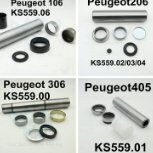-
Welcome to Auto Parts Forum
Whether you are a veteran automotive parts guru or just someone looking for some quick auto parts advice, register today and start a new topic in our forum. Registration is free and you can even sign up with social network platforms such as Facebook, X, and LinkedIn.
How To: Replace Rear Shock Absorbers
-
Similar Content
-
- 0 replies
- 50 views
-
- 0 replies
- 63 views
-
- 0 replies
- 102 views
-
- 0 replies
- 91 views
-
- 0 replies
- 88 views
-
-
Similar Topics
-
By austinbearing
Hello, everyone.We are an auto bearing manufacturer from China.
We produce Peugeot, Renault, Fiat and some other aut bearings.
Contact me if you're interested.
WhatsApp: +8613775640157
E-mail: [email protected]
-
By Counterman
ZF Aftermarket announced the launch of 33 new part numbers in March for SACHS Continuous Damping Control (CDC) shock absorbers for approximately 1.6 million passenger vehicles in operation in the U.S. and Canada (USC). The new products expand ZF’s line of SACHS CDC shock absorbers by more than 70 percent, reflecting growing demand for advanced damping technology in the aftermarket, according to ZF.
The CDC part numbers cover a variety of BMW and Audi models, among others. The CDC electronic damper system has been in large-scale original equipment production since the mid-2000s and is offered for many vehicles, from luxury cars to SUVs to compact cars. ZF said it has produced more than 35 million CDC dampers globally and plans to release additional CDC part numbers in the USC region throughout 2024.
“Demand for continuous damping control shocks is skyrocketing in the USC aftermarket, so we’re very excited to deliver more of this advanced damping technology to our customers, and to continue building the SACHS CDC product line,” said Mark Cali, head of independent aftermarket, USC for ZF Aftermarket.
The post
link hidden, please login to view appeared first on link hidden, please login to view.
link hidden, please login to view -
By OReilly Auto Parts
Automotive Shock and Strut Overview | What do they do and why are they important?
-
By NAPA
Honestly,
link hidden, please login to view are rarely a topic of discussion around automotive maintenance until something goes wrong. A torn CV boot seems like a minor issue at first, but if the situation is not remedied quickly, more damage will occur. A CV boot keeps lubricating grease from escaping the spinning link hidden, please login to view. Without grease, the CV joint will wear out rapidly. CV boots also protect the CV joint from water, dirt and road debris. For an often-forgotten replacement part, the CV boot performs a pretty critical job. For even more technical insight, check out “ link hidden, please login to view” CV boots aren’t just for front-wheel-drive vehicles either. Any vehicle design that must transmit power to a wheel, while also allowing for suspension movement, might utilize a CV joint. For example, a late-model, rear-wheel-drive
link hidden, please login to view has an independent rear suspension and two CV axles, each with two CV boots. A late-model, front-wheel-drive link hidden, please login to view also has two CV axles and four CV boots. But, in comparison, an all-wheel-drive link hidden, please login to view has four CV axles and a total of eight CV boots. Is It Possible Fix a CV Boot?
If you’re searching for a how-to guide on replacing a damaged CV boot, you came to the right place. Let’s walk through a CV boot replacement with the help of some NAPA expertise. Keep in mind, a CV axle boot replacement is only for
link hidden, please login to view that are still in good shape. If your CV axle is clicking or the CV boot was damaged and leaking grease for an extended length of time, you need to replace the entire CV axle. Installing a new CV boot and applying
link hidden, please login to view won’t fix an already damaged CV joint. Also, the labor to just replace a CV boot is nearly the same or greater than replacing the entire CV axle assembly. If the link hidden, please login to view costs as much as a new or rebuilt CV axle, the smart choice is to replace the entire CV axle. How Long Does It Take to Replace a CV Boot?
The time it takes for CV axle boot replacement varies by vehicle. Most of the labor time involves removing the CV axle from the vehicle. Budget at least an hour for the job if the CV axle is easy to remove or up to three hours if the vehicle is complicated. Cleaning the CV joint can take another 30 minutes as well.
How to Replace a CV Boot
A typical
link hidden, please login to view includes a new CV boot, two CV boot clamps and grease. Replacing a CV boot requires lifting the vehicle off the ground for easier access to the underside. A repair shop or well-outfitted home mechanic will utilize a vehicle lift, while a DIYer can use something as simple as sturdy link hidden, please login to view. Never use a floor jack to support a vehicle, as they can suddenly fail. Lift the vehicle off the ground. Use a wheel chock to prevent any wheels on the ground from rolling. Remove the wheel on the axle that needs repaired. Refer to a repair manual for what steps to follow to access the CV axle. You will likely need to remove the brakes and detach steering and/or suspension components, as well as the axle nut. Remove the CV axle from the vehicle and place it on a workbench with plenty of working space. Cut off the failed rubber CV boot. The metal CV boot clamps will likely require a pair of link hidden, please login to view. Due to the potential mess caused by the CV joint grease, we recommend wearing a pair of disposable work gloves for this step. Refer to your repair manual for how to remove the CV joint from the axle shaft. Note that inner and outer CV joints are possibly different and might require distinct methods of disassembly. Clean the axle shaft to remove any old grease. Use a link hidden, please login to view to clean the CV joint. Let the CV joint dry thoroughly. If using non-split CV boot clamps, slide them over the axle shaft now. Slide the new CV boot onto the axle shaft, taking care to orient it correctly. The large cone opening should face the CV joint. You may need to use a small amount of silicone lubricant to help move the boot along the axle shaft. Refer to your repair manual to link hidden, please login to view using the correct specified grease. Refer to your repair manual to reinstall the CV joint onto the end of the axle shaft. Slide the CV boot over the CV joint, making sure it is seated evenly. Using the link hidden, please login to view, tighten both CV boot clamps. Reinstall the CV axle along with any components that were removed to access the CV axle. Pay attention to torque specifications during reassembly. Reinstall the wheel and tighten the lug nuts to the correct specifications. Lower the vehicle back to the ground. How Much Does It Cost to Replace a CV Boot?
CV boot replacement cost can range from $300 to $900 depending on the vehicle. It is wise to price out replacement of the entire CV axle as well. In some cases, it is smarter to spend a little more money to replace the entire CV axle rather than spend time changing just a CV boot. Check out the
link hidden, please login to view for a better estimate of what this repair would cost for your vehicle (if applicable). Now that you know the typical steps of how to replace a CV boot, you can decide if this repair is something you can tackle yourself. Your local NAPA Auto Parts store can help you find the right CV axle boot repair kit for your application. You can also shop NAPAonline for
link hidden, please login to view on more than 160,000 items! Don’t feel like doing it yourself or don’t have the time? The link hidden, please login to view at your local link hidden, please login to view have you covered with more than 17,000 locations nationwide. Photo courtesy of
link hidden, please login to view. The post
link hidden, please login to view appeared first on link hidden, please login to view.
link hidden, please login to view -
By Dorman Products
Rear Crankshaft Oil Seal Installer - 635-000 #automobile #technician #gm #carrepair
-






Recommended Posts
Join the conversation
You can post now and register later. If you have an account, sign in now to post with your account.
Note: Your post will require moderator approval before it will be visible.